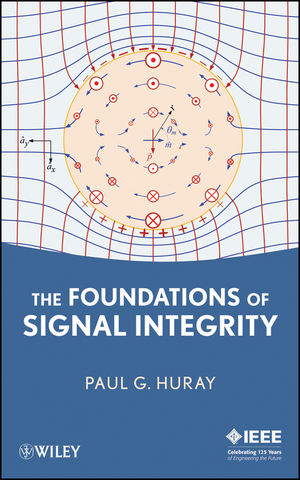The Foundations of Signal IntegrityISBN: 978-0-470-34360-9
Hardcover
360 pages
November 2009, Wiley-IEEE Press
 Other Available Formats: E-book
|
||||||
Intent of the Book.
1. Plane Electromagnetic Waves.
Introduction.
1.1 Propagating Plane Waves.
1.2 Polarized Plane Waves.
1.3 Doppler Shift.
1.4 Plane Waves in a Lossy Medium.
1.5 Dispersion and Group Velocity.
1.6 Power and Energy Propagation.
1.7 Momentum Propagation.
Endnotes.
2. Plane Waves in Compound Media.
Introduction.
2.1 Plane Wave Propagating in a Material as It Orthogonally Interacts with a Second Material.
2.2 Electromagnetic Boundary Conditions.
2.3 Plane Wave Propagating in a Material as It Orthogonally Interacts with Two Boundaries.
2.4 Plane Wave Propagating in a Material as It Orthogonally Interacts with Multiple Boundaries.
2.5 Polarized Plane Waves Propagating in a Material as They Interact Obliquely with a Boundary.
2.6 Brewster's Law.
2.7 Applications of Snell's Law and Brewster’s Law.
Endnote.
3. Transmission Lines and Waveguides.
3.1 Infi nitely Long Transmission Lines.
3.2 Governing Equations.
3.3 Special Cases.
3.4 Power Transmission.
3.5 Finite Transmission Lines.
3.6 Harmonic Waves in Finite Transmission Lines.
3.7 Using AC Spice Models.
3.8 Transient Waves in Finite Transmission Lines.
4. Ideal Models vs Real-World Systems.
Introduction.
4.1 Ideal Transmission Lines.
4.2 Ideal Model Transmission Line Input and Output.
4.3 Real-World Transmission Lines.
4.4 Effects of Surface Roughness.
4.5 Effects of the Propagating Material.
4.6 Effects of Grain Boundaries.
4.7 Effects of Permeability.
4.8 Effects of Board Complexity.
4.9 Final Conclusions for an Ideal versus a Real-World Transmission Line.
Endnotes.
5. Complex Permittivity of Propagating Media.
Introduction.
5.1 Basic Mechanisms of the Propagating Material.
5.2 Permittivity of Permanent Polar Molecules.
5.3 Induced Dipole Moments.
5.4 Induced Dipole Response Function, G(τ).
5.5 Frequency Character of the Permittivity.
5.6 Kramers–Kronig Relations for Induced Moments.
5.7 Arbitrary Time Stimulus.
5.8 Conduction Electron Permittivity.
5.9 Conductivity Response Function.
5.10 Permittivity of Plasma Oscillations.
5.11 Permittivity Summary.
5.12 Empirical Permittivity.
5.13 Theory Applied to Empirical Permittivity.
5.14 Dispersion of a Signal Propagating through a Medium with Complex Permittivity.
Endnotes.
6. Surface Roughness.
Introduction.
6.1 Snowball Model for Surface Roughness.
6.2 Perfect Electric Conductors in Static Fields.
6.3 Spherical Conductors in Time-Varying Fields.
6.4 The Far-Field Region.
6.5 Electrodynamics in Good Conducting Spheres.
6.6 Spherical Coordinate Analysis.
6.7 Vector Helmholtz Equation Solutions.
6.8 Multipole Moment Analysis.
6.9 Scattering of Electromagnetic Waves.
6.10 Power Scattered and Absorbed by Good Conducting Spheres.
6.11 Applications of Fundamental Scattering.
Endnotes.
7. Advanced Signal Integrity.
Introduction.
7.1 Induced Surface Charges and Currents.
7.2 Reduced Magnetic Dipole Moment Due to Field Penetration.
7.3 Infl uence of a Surface Alloy Distribution.
7.4 Screening of Neighboring Snowballs and Form Factors.
7.5 Pulse Phase Delay and Signal Dispersion.
Chapter Conclusions.
Endnotes.
8. Signal Integrity Simulations.
Introduction.
8.1 Defi nition of Terms and Techniques.
8.2 Circuit Simulation.
8.3 Transient SPICE Simulation.
8.4 Emerging SPICE Simulation Methods.
8.5 Fast Convolution Analysis.
8.6 Quasi-Static Field Solvers.
8.7 Full-Wave 3-D FEM Field Solvers.
8.8 Conclusions.
Endnotes.
Bibliography.
Index.



